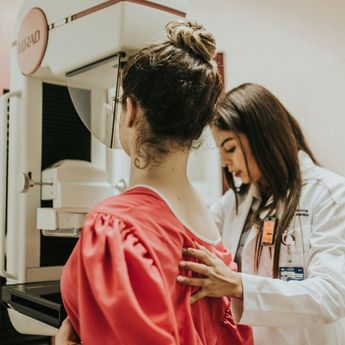By continuing to use our site, you consent to the processing of cookies, user data (location information, type and version of the OS, the type and version of the browser, the type of device and the resolution of its screen, the source of where the user came from, from which site or for what advertisement, language OS and Browser, which pages are opened and to which buttons the user presses, ip-address) for the purpose of site functioning, retargeting and statistical surveys and reviews. If you do not want your data to be processed, please leave the site.
The Voice of People With Breast Cancer
Information
Breast Cancer Basics
High Risk Conditions
Lobular Carcinoma In Situ (LCIS)
What are breast lobules?
Breast lobules are small, round structures in the breast that produce milk. They are present in all breasts capable of producing milk, not only among people who have been pregnant or breastfed.
Lobular carcinoma in situ (LCIS) occurs when abnormal cells grow within the lobules but do not spread to nearby tissue. Despite the term "carcinoma," LCIS is not cancer; however, it increases the risk of developing invasive breast cancer by 7 to 12 times. Approximately 1 in 10 people with LCIS will develop breast cancer.
LCIS is similar to atypical lobular hyperplasia (ALH), but is more extensive. It is found in 0.5% to 1.5% of benign breast biopsies and is most commonly diagnosed before menopause, with an average age of 44 to 49 years.
Types of LCIS
- Classic LCIS: The cells lining the breast lobules are smaller and are about the same size.
- Pleomorphic LCIS: The cells lining the lobules are larger and appear more abnormal compared to classic LCIS.
- Florid LCIS: The cells grow into large clusters that can form a mass, often containing an area of dead cells in the center, known as central necrosis.
Diagnosing LCIS
LCIS typically doesn't cause noticeable symptoms. Classic LCIS is usually not visible on mammograms, but pleomorphic and florid LCIS may sometimes be detected this way. LCIS is most often found during a breast biopsy, typically following an abnormal mammogram result or when evaluating another concern.
Treating and Managing LCIS
Management options vary based on individual risk factors, and may include:
Close Monitoring
A “wait and see” approach may be recommended, which involves regular breast exams and increased screening, such as mammograms and possibly additional imaging like MRIs or ultrasounds.
Medications to Lower Breast Cancer Risk
Estrogen is a natural hormone in the body that has been found to increase the risk of developing breast cancer and making breast tumours grow. Certain drugs that reduce the risk of developing breast cancer by blocking the effects of estrogen may be suggested for individuals diagnosed with LCIS. Additionally, aromatase inhibitors, which stop the enzyme aromatase from converting other hormones into estrogen, may also be used. Common medications include:
- Tamoxifen (for pre and postmenopausal individuals)
- Aromatase inhibitors (for postmenopausal individuals)
- Raloxifene (for postmenopausal individuals)
These medications lower the risk of estrogen receptor (ER) - positive breast cancer, but not ER-negative types. If you are taking estrogen-based medications (e.g., birth control), your healthcare provider may recommend discontinuing them to further reduce your risk.
Surgery
In some cases, surgical options may be considered, particularly for individuals with additional high-risk factors. Surgical options include:
- Ultrasound-guided, vacuum-assisted excision: A minimally invasive procedure that removes abnormal breast tissue, often used for pleomorphic and florid LCIS, which may grow quickly.
- Lumpectomy: Removal of abnormal tissue along with surrounding healthy tissue.
- Prophylactic Mastectomy: Removal of one or both breasts. This option may be considered for individuals who have other high-risk factors for developing breast cancer, including a family history of breast cancer or having dense breasts.
Medical Review by Roochi Arora, MD, FRCPC, August 2025
- References
-
American Cancer Society. (2022). Lobular carcinoma in situ (LCIS). Cancer.org. https://www.cancer.org/cancer/types/breast-cancer/non-cancerous-breast-conditions/lobular-carcinoma-in-situ.html
Cleveland Clinic. (2024). Lobular carcinoma in situ (LCIS). https://my.clevelandclinic.org/health/
diseases/21791-lobular-carcinoma-in-situ-lcisDePolo, J. (2023). Lobular carcinoma in situ (LCIS) and atypical lobular hyperplasia. Breastcancer.org. https://www.breastcancer.org/benign-breast-conditions/lobular-carcinoma-in-situ-atypical-lobular-hyperplasia
Health Canada. (2006). Product monograph: Apo-raloxifene. https://pdf.hres.ca/dpd_pm/00002184.PDF
Susan G. Komen. (2024). Breast cancer risk factors: Lobular carcinoma in situ (LCIS). https://www.komen.org/breast-cancer/risk-factor/lobular-carcinoma-in-situ
Wen, H. Y., & Brogi, E. (2018). Lobular carcinoma in situ. Surgical Pathology Clinics, 11(1), 123–145. https://doi.org/10.1016/j.path.2017.09.009
SHARE




